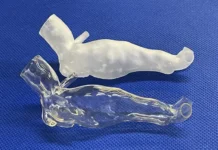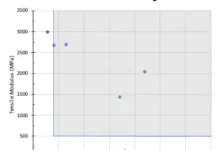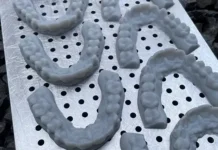Compiled with assistance from Dr. Linkan Bian, National Science Foundation
In collaboration with the National Institutes of Standards and Technology, a key component of PAMA activities is to foster public/private partnerships and academic research in the area of photopolymer additive manufacturing (PAM) technology. The National Science Foundation (NSF) has been an important resource in supporting research activities, funding several PAM/3D printing research initiatives. Dr. Linkan Bian, program director with NSF, will join the PAMA Workshop in Boulder in September 2023 for a panel on Leveraging Public/Private Partnerships for PAM Success, chaired by Dianne Poster, a PAMA Executive Advisory Board member, with NIST.
Dr. Bian kindly prepared this listing of recent NSF awards for photopolymer AM projects. In each case, the National Science Foundation notes, “This award reflects NSF’s statutory mission and has been deemed worthy of support through evaluation using the Foundation’s intellectual merit and broader impacts review criteria.”
Additional information can be found at www.nsf.gov/awardsearch/.
Award Recipient: University of Pittsburgh
Start Date: May 1, 2023
End Date: April 30, 2028 (estimated)
Total Intended Award Amount: $657,610
Total Award Amount to Date: $657,610
This Faculty Early Career Development (CAREER) grant supports research to elucidate the fundamental science of light propagation and photochemistry reactions for establishing a smart dual-wavelength photoinhibition aided PAM process. This new process allows to manipulate cure and curb exposures of the PAM processing so that the geometrical fidelity and functional integrity can be enhanced. If successful, this project will impact numerous applications including biochips, electrodes, soft robots, metamaterials, and others that demand precision manufacturing of parts with complex shapes and strengthened performance.
The overarching goal of this CAREER project is to realize Rapid, Intelligent, Precise, Extensive, Sustainable, and Transformative (RIPEST) PAM. The primary research objective is to establish a novel digital light processing method – DLP2Curb that capitalizes on photoinhibition induced by a second wavelength light to curb curing parts, via a holistic cyber-physical approach that combines physics-guided surrogate modeling with real-time sensing and control. Thrust 1 elaborates the DLP2Curb process dynamics and materials behavior through multiple physical regimes, temporal stages, and spatial scales to unravel the causes of overcuring and the curb reaction paths by constructing a digital twin. Thrust 2 aims to achieve non-contact, full-field operando characterization of PAM in real time. In-process part properties will be measured by deploying in-situ interferometric and ultrasonic monitoring systems along with physical sensor models and data analytics methods. Thrust 3 develops a real-time control method via deep reinforcement learning of model predictions and in-situ measurements feedback. With case studies such as micropillars and lattices, this project will demonstrate the potential ability of DLP2Curb to unlock efficient precision manufacturing of sophisticated parts with exact geometry and exquisite details.
Award Recipient: University of Rochester
Start Date: April 1, 2023
End Date: March 31, 2026 (estimated)
Total Intended Award Amount: $355,714
Total Award Amount to Date: $355,714
The total energy consumption by opto-electronic devices is predicted to surpass the global energy production by the year 2040 unless radical changes are made in their design and manufacturing and large improvements in their performance. This grant supports research that helps to alleviate this challenge by pioneering an innovative manufacturing approach that enables novel and highly efficient three-dimensional chip designs that do not rely on unsustainable miniaturization of the traditional chip architectures. Such three-dimensional architectures are only accessible via new bottom-up manufacturing processes that build and assemble devices in an additive manner via atomically precise and self-aligned positioning of the device components. Current top-down manufacturing does not leverage energy-efficient chemical processes that can significantly reduce manufacturing energy requirements, nor does it benefit from spontaneous molecular and atomic self-organization phenomena that can reduce the size of the chip components. The goal of this research is to develop a continuous, energy-efficient manufacturing platform for bottom-up deposition and high-resolution patterning of opto-electronic device components. The project impacts a broad range of research fields, including electronics, sensing, catalysis, and optical technology as well as training of the future manufacturing workforce.
Award Recipient: University of California, Davis
Start Date: September 1, 2022
End Date: August 31, 2025 (estimated)
Total Intended Award Amount: $470,298
Total Award Amount to Date: $470,298
This award supports fundamental research to modify existing photolithography tools and methods and enables optical micropatterning of organic semiconducting polymers into electronic circuits. The new processing tool enables micro and nanopatterning, controlled doping and layering of a broad class of organic electronic materials that currently cannot be micro or nanopatterned into functional devices, such as, flexible electronics and wearables. Results from this research enables advancements in many applications such as chemical sensing, neuromorphic computing, and medical diagnostics. The ensuing technological impacts result in economic opportunities in healthcare, energy, and environment. This research lowers the cost for production of prototype organic electronic devices by orders of magnitude, which spurs economic growth and national prosperity. The project partners with instrument manufacturers, trains students at all levels and broadens participation of women and under-represented minorities.
Funding in 2021 included the following:
Award Recipient: Massachusetts Institute of Technology
Start Date: September 1, 2021
End Date: August 31, 2024 (estimated)
Total Intended Award Amount: $382,192
Total Award Amount to Date: $382,192
This award will support research on the first AM technique for recyclable thermoplastic materials that utilizes photopolymerization, called Interfacial Photopolymerization (IPP). This work combines fundamental materials science and manufacturing scale-up to enable the digital production of intricate, high resolution thermoplastic objects using commercially available feedstock materials. This work will have economic and environmental benefits by opening new applications in automotive, aerospace, consumer, and medical device industries that use recyclable plastics, which is a vital contribution to the sustainability of our world.
Award Recipient: Rensselaer Polytechnic Institute
Start Date: January 1, 2021
End Date: December 31, 2023 (estimated)
Total Intended Award Amount: $531,361
Total Award Amount to Date: $531,361
Thermoset structures containing stiff and soft domains that mimic the hierarchical structure of bone, nacre, bamboo and pearlite steels will be developed by using stereolithography 3D printing in conjunction with phase separation. The experimental work will be guided by modeling to optimize the network structure and the multiscale architecture of the material, in order to achieve strength and toughness of the additive manufactured (AM) parts superior to those of the structurally homogeneous thermosets used today. Polymer nanocomposite AM parts are increasingly important for applications in dental, biomedical, wearable electronics, aerospace, and automotive industries.
Award Recipient: Brown University
Start Date: May 1, 2021
End Date: April 30, 2024 (estimated)
Total Intended Award Amount: $500,000
Total Award Amount to Date: $513,400
Universal access to biological tissues for fundamental studies is limited, thereby constraining both the type and number of experiments that can be readily carried out. This grant supports research to mitigate this challenge by extracting and storing tissue-structure information, which will be made broadly accessible. The detailed information is obtained through the sequential process of imaging (reading), digitally storing, and laser-based manufacturing (writing) of the tissue architecture. This award utilizes a convergence of disciplines to create a digital manufacturing platform, based on two-photon polymerization (TPP), that will enable cloud-based reading and writing of scaffolds with varying complexity in 3D collagen-fiber organization.






